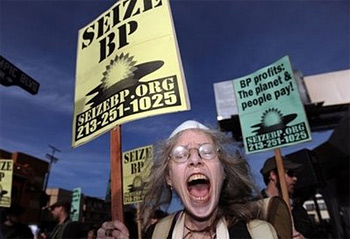
|  |  |  Americas & Beyond Americas & Beyond  
BP Launches New Bid to Stem Gulf of Mexico Oil Spill
 Clement Sabourin – Agence France-Presse Clement Sabourin – Agence France-Presse
go to original
May 13, 2010


| | A protester shouts slogans against BP during a demonstration in front of the BP "Green Curve" Station, in Los Angeles, California. Three weeks into the Gulf of Mexico oil disaster, BP engineers readied a new "top hat" containment dome Thursday to cap the ruptured well that has spewed a sea of crude toward the US coast. (AFP/Gabriel Bouys) |  |
New Orleans, Louisiana – BP prepared Thursday for a make-or-break bid to stop oil spewing into the Gulf of Mexico by inserting a tube into the main leak and siphoning the crude up to a tanker on the surface.

Remote-controlled submarines will perform the delicate operation to insert a narrow six-inch (15-centimeter) diameter tube into the 21-inch thick riser pipe in inky depths 1,500 meters (5,000 feet) down on the seabed.

"There will be a set of gaskets attached to the tube and they will help seat it in the riser pipe," BP spokesman Bryan Ferguson said, explaining that avoiding debris at such depths and pressure was far from "failsafe".

Success could see most of the leaking oil contained and allow BP to concentrate its efforts on mopping up the giant slick that has been threatening the fragile shores of Louisiana, Mississippi and Alabama for weeks.

Engineers decided to use the insertion tube method rather than a "top hat" containment box because they were concerned about the creation of ice-like crystals that dogged efforts last weekend with its giant "dome" predecessor.

"The thought was the riser insertion tube is essentially connecting one piece of pipe to another and it reduces the chamber effect that leads to the creation of hydrates," explained Ferguson.

The Deepwater Horizon rig, leased by BP from Transocean, the world's largest offshore drilling contractor, sank on April 22, two days after a massive explosion that killed 11 workers.

An estimated 210,000 gallons of crude a day has since been streaming into the sea from the fractured riser pipe and has created a slick that could ruin fragile wetlands and nature reserves in Louisiana and beyond.

BP has come under increasing pressure to fix the leak, as congressional hearings on Tuesday and Wednesday revealed multiple warning signs were perhaps overlooked before the April 20 blast.

Top oil executives from BP, rig owner Transocean and Halliburton, which was being paid to seal the well, traded blame over the disaster.

"The more I learn about this accident, the more concerned I become," House Energy and Commerce Committee Chairman Henry Waxman said Wednesday as US lawmakers sifted through 100,000 pages of testimony.

"This catastrophe appears to have been caused by a calamitous series of equipment and operational failures."

One of the main questions is why BP or Transocean decided to go ahead with final operations to seal the well despite a test that apparently indicated highly combustible gas could still be leaking out.

Citing accounts by two contractors, The Wall Street Journal said a decision was also taken to conduct the final operations in reverse, meaning the drilling "mud," or lubricant, was withdrawn before a final cement plug was inserted.

Engineers have been mulling several different options to seal the main leak which has spewed out an estimated 4.5 million gallons so far, and prevent a giant slick from destroying vulnerable coastlines.

In addition to the "top hat", BP is contemplating a bizarre "junk shot" maneuver to jam up the blowout preventer (BOP) with golf balls, tires, rope and other debris.

If the latest efforts fail to stem the tide of leaking oil, southern US Gulf states from Texas to Florida face an anxious wait.

BP began drilling a relief well on May 2 that could divert the flow until the well is permanently sealed, but this may not be ready until August.

Louisiana's 2.4 billion dollar fisheries industry has already been hit by a ban on fishing and shrimp harvesting in a large swath of coastal waters.

Clean-up teams are seeing oil wash up on island nature reserves in Louisiana and National Guard troops in hazmat gear have been scooping up tar balls off beaches on Dauphin Island, a popular Alabama tourist spot.

Transocean, which BP is blaming for the failure of the blowout preventer, filed a petition in a US court Thursday to limit its liability in the spill to 27 million dollars.

BP, meanwhile, said the spill had so far cost it 450 million dollars.

And US senators from the three Pacific coast western states introduced draft legislation calling for a ban on new offshore drilling.
|

 |
|  |



